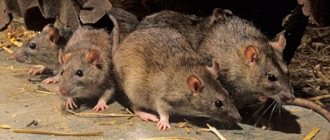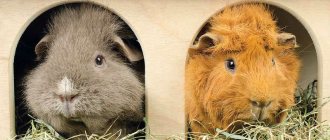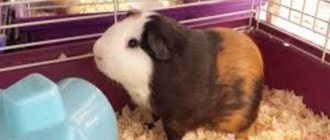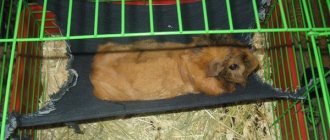Baby guinea pigs are fragile creatures. Even in keeping adult animals there are rules, the violation of which leads to a deterioration in their health and appearance. Newborn animals must be handled with extreme caution. To avoid undesirable consequences, you should carefully study the features of caring for your guinea pig's offspring.
Puberty
Appears quite early:
- The first heat in females is observed at 8 weeks,
- males mature a little later - usually by three months of age.
But puberty does not mean that rodents can and should mate. At such a young age, the body is not fully formed, and mating will not give the expected results: either fertilization will not occur, or the litter will not be viable.
In addition, early coating seriously undermines the health of the pet, especially females. After unjustified haste throughout her life, she will often get sick, and, consequently, bear weak and underdeveloped offspring. The danger of early mating also lies in the possible death of the animal during childbirth, when the pelvis and birth canal are not yet sufficiently developed.
Experienced breeders recommend using animals at least 10 months old to produce healthy offspring. In some cases, younger six-month-old individuals are also used for these purposes.
It is important to understand that living conditions, diet, and breed play a significant role in the onset of puberty.
Selection of animals for breeding
It matters a lot. Pigs must be:
- well-fed,
- agile and cheerful,
- absolutely healthy,
- have excellent breed qualities,
- with wool of excellent quality and characteristic color.
A female should not be bred more than twice a year, since frequent “work” undermines her health and, as a result, her offspring will be weak and of poor quality. Uncontrolled use of males will also lead to unpleasant consequences - the potential mother will remain unfertilized.
A week before and during mating, animals are given food rich in vitamin E - sprouted wheat, barley, oats, as well as succulent food. The best time for reproduction is considered to be spring and summer, when there is a lot of varied food.
Obese, overly dense or thin, sick animals should not be allowed to crossbreed.
Mating
For one male there should be from 5 to 10 female pigs. Some breeders keep them together, others separately - there is no fundamental difference. In the case of separate keeping, the female during estrus is placed in a cage with a “man”.
The hunt lasts about two days, the frequency of estrus is 13-20 days. The favorable period for fertilization lasts about 10 hours. The female takes a characteristic pose (she is motionless, her hind legs are apart, her croup is raised) and is ready to let her partner approach her.
Care during pregnancy
A pregnant guinea pig needs special care. She needs to be provided with complete rest. It is best to organize a special house for these purposes, where the animal could hide and subsequently hatch babies.
Pay attention to feeding the animal. Food should be complete, rich in protein and vitamins. It is recommended to give:
- green food,
- root crops,
- sprouted grain.
At the beginning of pregnancy, the amount of food is increased by 1/3, and at the end the female should receive twice as much food. Number of feedings up to four times a day.
Access to water is unlimited. The presence of fluid is especially important at the end of gestation, when the animal is very thirsty. Along with water, the expectant mother is also given milk; it should be warm.
General feeding rules
The recommended daily ratio of all types of food looks like this:
- dry food – 5-10% (no more than a tablespoon);
- juicy food – 30%;
- hay – 60%.
If there is no dry food on the menu, an adult pig should eat approximately 150 g of vegetables per day. She is served vegetables every day, and is pampered with berries and fruits from time to time. Vegetable dishes are certainly complemented with leafy greens, which compensate for the lack of vitamins.
Do not keep your rodent on a mono-diet, feeding it only carrots or beets: this will provoke health problems. It’s great if there are different products on his table every day: parsley will be replaced by dill/basil, and celery by carrots/zucchini. An approximate daily diet consists of 3 types of vegetables and herbs.
Fundamentally! Do not collect plants near highways, factories, or in swampy areas. Dry the weed for more than 1.5-2 months: it should not be blackened or rotten.
Do not forget to ensure an uninterrupted supply of hay (especially during the cool season): the guinea pig chews it all the time, without limiting itself in volume. Hay restores digestion and is necessary for proper grinding of teeth.
Legume and legume-cereal hay is considered the most valuable. The rodent will also thank you for the vitamin herbs (nettle, alfalfa and shamrock) that you prepare in the summer. These plants will be an excellent food for growing and pregnant animals.
Vitamins and minerals
The rodent's body is not capable of producing vitamin C, so you will have to give it 5-25 mg of ascorbic acid, dissolving it in water. Such feeding is excluded if the purchased food contains a multivitamin composition. Guinea pigs cannot live without salt: 0.5 g per day for a young animal, and three times more for an adult.
Mineral pebbles act as suppliers of salts and calcium, especially needed in winter (when the amount of lush greenery responsible for microelements is reduced).
Inexperienced “pig farmers” may be frightened by the sight of a pet eating its own litter. Meanwhile, this is a completely normal phenomenon: this is how guinea pigs move vitamins K and B through the digestive tract (they are absorbed only when they enter the stomach again).
Refuse boiled water in favor of filtered or still (bottled) water. The water is changed when it becomes dirty, because pieces of food often get into it. One pig will be happy with a 250 ml drinker, which should always be filled.
Do not forget that females nursing or bearing cubs need more fluid.
Sources:
https://homkin.ru/morskie-svinki/zdorovie-morskih-svinok/novorozhdennye.html https://zoolacky.ru/kroliki-i-morskie-svinki/chem-kormit-beremennuyu-morskuyu-svinku.html https: //womanadvice.ru/chem-kormit-morskuyu-svinku https://dasinok.ru/domashnie-lyubimcy/chem-kormit-morskuyu-svinku.html https://simple-fauna.ru/pets/gryzuny/chem- kormit-morskuyu-svinku/
Pregnancy
Naturally, all novice pig breeders are interested in the question: how long do pregnant guinea pigs walk? So this period lasts differently for everyone: from 60 to 68 days. Much depends on the number of cubs. There were cases when, with a small litter, a pig carried offspring for 72 days.
You can tell if your guinea pig is pregnant by its enlarged belly and weight gain. Usually visual changes are visible on the 20th day from the beginning of fertilization. When palpating, an attentive owner can even “listen” to the movements of the fetus; they become more noticeable at the end of pregnancy.
During this period, the animal must be handled with the utmost care, since excessive anxiety will lead to abortion:
- you shouldn’t pick her up often,
- disturb you once again with inspections of the house or frequent cleaning,
- move the cell from place to place.
By the way, miscarriage or premature birth can be caused by an infectious disease - brucellosis. Therefore, even before mating, it is advisable to donate blood for analysis to a laboratory where they can detect or not detect antibodies for this disease.
Acquaintance
Before moving directly to mating animals, it is necessary to introduce them. 6-7 days before the expected start of estrus, it is recommended to place the female and male cages side by side. This way they can take a closer look and smell each other. After another couple of days, you can organize several meetings on neutral territory (for example, in a separate cage).
The absence of aggression, especially on the part of the female, and the manifestation of mutual interest signals the rodents' readiness to create a pair. From this moment, you can begin to sit down a potential couple. This must be done in accordance with the following rules:
- For boarding, you need to purchase a new spacious cage without stairs or floors. As a last resort, you can place the female with the male.
- Before settling pigs in one territory, they should be bathed in order to neutralize the unfamiliar aroma of their neighbor.
- Before planting, you need to rub the future parents with hay with the smell of their partner. This will help them find a common language faster.
- The floor of the cage should be covered with enough hay and treats to prevent the pigs from having food conflicts. In addition, eating food together helps the rodents get closer together.
- On the first day of cohabitation, the owner should always be near the cage so that in case of a conflict, he can quickly seat the animals.
- It is recommended to seat the partners 1-2 days before the heat. This measure will increase the quality of the male’s sperm.
Important! If you cannot breed guinea pigs or crossing does not bring results for more than 6 months, you should think about selecting other partners for the animals.
Some guinea pig owners prefer not to waste time on preliminary introductions to their pets, and introduce their pets only on the day of the planned crossing. This is not recommended, since unprepared animals often get into bloody fights with a stranger.
How does childbirth go?
Sooner or later, a guinea pig's pregnancy ends in birth. They are usually swift and pass at night. Before the cubs appear, the female prepares by arranging a nest. The babies are born one after another, the break is no more than five minutes.
Newborn guinea pigs are enveloped in membranes, which the female nibbles and eats. If for some reason the mother does not remove the membrane, it must be removed independently. Otherwise, the baby will suffocate.
If problems arise during childbirth, first aid is provided. The pig is massaged in the abdominal area, stroking movements are directed towards the birth canal.
Baby care
After the guinea pig has given birth, there is nothing special for a person to do, since the mother herself is capable of caring for the offspring. Usually 1 to 5 cubs are born. Their weight is about 50-100 g (it all depends on the size of the litter), they are covered with hairs, have teeth, their eyes are open and in just a few minutes they can move independently.
The female has only two nipples, but they are quite enough to feed all the offspring - the newborns suckle in turns. From the third day, babies begin to try food for adult animals.
It is not recommended to pick up piglets immediately after birth. At one month of age they are placed in a separate terrarium.
If for some reason the pig refuses to feed the babies or she does not have milk, the cubs are transferred to artificial feeding or placed with another mother. Before this, the piglet’s fur is wiped with sawdust taken from the stepmother’s cage so that the latter can better accept the foundling.
You can also raise offspring using artificial feeding. To do this, newborns are administered 1 cc using a pipette. see baby formula every two hours for a week. They are also given hay and green food.
Do not forget to stimulate defecation and urination in orphans using a cotton pad, which is used to irritate the anal area.
When can you give away guinea pigs after birth?
Guinea pig cubs can be separated from the 4th week, when they have already finished feeding on milk. But until 5–6 weeks, milk or cream is manually added to their diet. Too early weaning from mother's milk threatens pigs with disturbances in growth and development. And vice versa - a long stay with the offspring negatively affects the female herself. Prolonged breastfeeding undermines her health. For this reason, the most well-fed cubs are placed first.
At the age of one month, males have already reached puberty and until this moment must be separated from their mother and other females. From this age, pigs can be distributed to new owners.
Possible problems during breeding
- Death of offspring. It occurs for various reasons. One of the most common is that the mother does not accept the babies, which happens due to poor maternal instinct or lack of milk as a result of the stress of childbirth. It is better to cull such females immediately and not allow them to reproduce. Often a young mother herself can destroy her offspring due to excessive anxiety, when she endlessly drags them around in search of a safe place.
- Refusal to breastfeed. In this case, the mother is still kept close to the brood, but the babies are fed. After some time, the female can resume feeding. If there are problems with milk production, then it is better to discard such a mother and transfer the cubs to artificial feeding.
- Birth of stillborn piglets. The reasons are poor maternal feeding, vitamin deficiency, lack of micro-, macroelements or infection.
Breeding guinea pigs at home is not a difficult task at all, but even it should be approached with full responsibility, choosing the right breeders and providing comfortable conditions. Only in this case can you get healthy and full-fledged offspring.
Matching
The success of crossing guinea pigs depends on the correct selection of a pair. Only healthy animals of the same age, with normal body weight (at least 700 g) and no defects in appearance are allowed to reproduce. You also need to pay attention to your teeth. If parents have dental problems, their offspring will inherit them. You will need to refuse breeding in the following cases:
- pets show unreasonable aggression;
- potential partners are severely emaciated or, conversely, suffer from obesity;
- animals are weakened by a recent illness;
- pets have signs of pain: dull fur, poor appetite, lethargy, drowsiness.
Also, roan guinea pigs or Dalmatians are not suitable for crossing. Animals of these colors often produce non-viable offspring. Babies may be born deaf, blind (or without eyes at all), with crooked, brittle teeth. Typically, such individuals live no longer than a few weeks.











